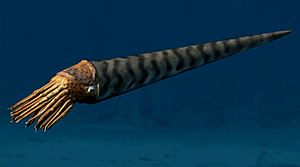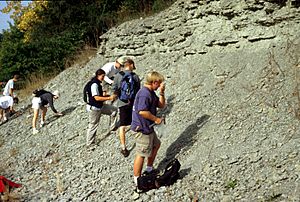Ordovician facts for kids
The Ordovician Period was the second major time period of the Paleozoic Era. It lasted for about 42 million years, from 485.4 million years ago (mya) to 443.4 mya. It came after the Cambrian Period and before the Silurian Period.
This period was named after the Ordovices, an ancient Welsh tribe. A scientist named Charles Lapworth first defined it in 1879. He noticed that the fossils in certain rock layers were different from those in the Cambrian or Silurian periods. Because of this, he believed these rocks should have their own separate time period.
At first, people in Britain were slow to accept the Ordovician Period. But in other parts of the world, it was quickly recognized. In 1906, the International Geological Congress officially adopted it as a period of the Paleozoic Era.
The Ordovician Period ended with a series of huge extinction events. These events caused the second-largest extinction of all time in Earth's history. This is known as the End–Ordovician extinction event.
Contents
Earth's Changing Face: Geology
Ancient Geography
During the Ordovician Period, sea levels were very high. Shallow seas, less than 50 meters deep, covered more land than at any other time in Earth's history. We can see evidence of these seas in the rocks today.
The southern continents joined together to form one giant continent called Gondwana. At the start of the Ordovician, Gondwana was near the equator. As the period went on, it slowly moved towards the South Pole. Other continents like Laurentia (which is now North America), Siberia, and Baltica (now northern Europe) were still separate.
Ocean Chemistry
The Ordovician was a time when the ocean chemistry favored calcite. This meant that a type of calcite with low magnesium was the main material that formed calcium carbonate in the oceans. This was important for marine life that built shells and skeletons.
Amazing Ocean Life: Fauna

For most of the Ordovician Period, life in the oceans thrived. However, near the end, the End–Ordovician extinction event caused big problems. Tiny floating creatures like conodonts and graptolites were hit hard. Some groups of trilobites also suffered. Brachiopods, bryozoans, and echinoderms were greatly affected. The cone-shaped nautiloids almost completely disappeared.
Scientists think a huge ice age might have caused these extinctions. The end of the Ordovician was one of the coldest times on Earth in the last 600 million years.
Life's Big Boom: Adaptive Radiation
The types of animals that appeared in the Ordovician set the stage for the rest of the Paleozoic Era. Most of these animals were "suspension feeders." This means they ate tiny particles floating in the water. The food chains were short and simple. The overall ocean ecosystem became much more complex than it was in the Cambrian Period.
While the Cambrian explosion is famous, the Ordovician also had an amazing burst of new life. This is called an adaptive radiation. The number of different types of marine animals increased four times! This meant that 12% of all known marine animals from the entire Phanerozoic Eon appeared during the Ordovician.
Another big change was the huge increase in "filter feeding" organisms. These animals filter water to get their food. Articulate brachiopods, cephalopods, and crinoids became very common. Articulate brachiopods especially took over from trilobites in many ocean communities. This shows how much the variety of shell-making creatures grew in the Ordovician. Even though single corals existed before, the first coral reefs appeared in the early Ordovician.
Molluscs, which first appeared even earlier, became very common and diverse. This included bivalves (like clams), gastropods (like snails), and nautiloid cephalopods. Extinct marine animals called graptolites also thrived in the oceans. Some new types of cystoids and crinoids appeared too.
For a long time, scientists thought the first true vertebrates (animals with backbones), like Ostracoderm fish, appeared in the Ordovician. But new discoveries in China show they likely appeared earlier, in the Lower Cambrian. The very first fish with jaws, called Gnathostomata, appeared in the Upper Ordovician.
During the Middle Ordovician, there was a big increase in organisms that bored into shells and rocks. This is called the Ordovician Bioerosion Revolution. We can see many new types of trace fossils (marks left by living things) in hard surfaces from this time.
In the Lower Ordovician, many new creatures joined the trilobites. These included new types of brachiopods, bryozoans, floating graptolites, and conodonts. Many types of molluscs and echinoderms also appeared, including "brittle stars" and the first sea stars. Trilobites were still very common, with all the groups from the Late Cambrian continuing. A new group called Phacopida also appeared. The first signs of plants on land also showed up during this period.
Ordovician trilobites were quite different from their Cambrian ancestors. Many developed strange spines and bumps to protect themselves from predators like early sharks and nautiloids. Other trilobites evolved to swim. Some even had shovel-like snouts to dig through muddy seafloors. Some trilobites, like Asaphus kowalewski, grew long eyestalks to spot predators. In contrast, other trilobite eyes disappeared completely.
Amazing New Fossil Discoveries
The famous Burgess Shale fossils, known for their soft-bodied creatures, seemed to disappear in the Middle Cambrian. However, scientists now know that these types of animals did not go extinct. They survived and thrived where conditions were right. A recently found fossil site in the Fezouata Formation in Morocco has amazing fossils of soft-bodied animals from a muddy ocean floor. This site also has hard-bodied animals like horseshoe crabs. It's thought that low oxygen levels in the water kept predators and scavengers away, helping these delicate fossils to be preserved.
Images for kids
-
Brachiopods and bryozoans in an Ordovician limestone, southern Minnesota.
-
Platystrophia ponderosa, Maysvillian (Upper Ordovician) near Madison, Indiana. Scale bar is 5.0 mm.
-
Zygospira modesta, spiriferid brachiopods, preserved in their original positions on a trepostome bryozoan; Indiana.
-
Graptolites (Amplexograptus) from the Ordovician near Caney Springs, Tennessee.
-
External mold of Ordovician bivalve showing that the original aragonite shell dissolved on the sea floor, leaving a cemented mold for biological encrustation (Waynesville Formation of Franklin County, Indiana).
-
The trilobite Isotelus from Wisconsin
-
Upper Ordovician edrioasteroid Cystaster stellatus on a cobble from the Kope Formation in northern Kentucky with the cyclostome bryozoan Corynotrypa in the background
-
Bryozoan fossils in Ordovician kukersite oil shale, northern Estonia
-
The Ordovician cystoid Echinosphaerites (an extinct echinoderm) from northeastern Estonia; approximately 5 cm in diameter
-
Prasopora, a trepostome bryozoan from the Ordovician of Iowa
See also
 In Spanish: Ordovícico para niños
In Spanish: Ordovícico para niños






















